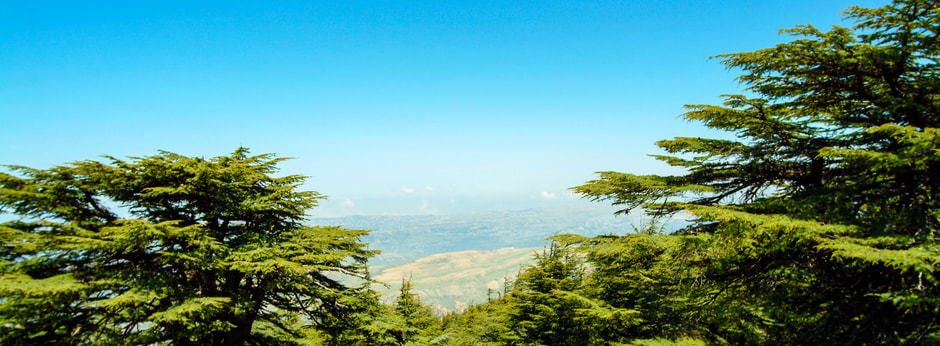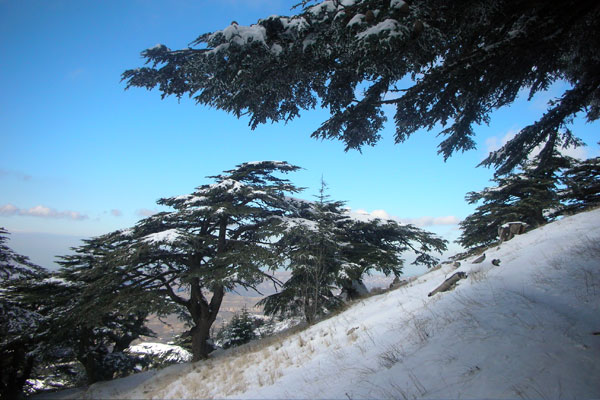|
Graham Pitts In 2011, I visited Lebanon’s Shouf Biosphere Reserve to see what I could discover about the history of the country’s forests. Located on the slopes of the Barouk range of the Lebanese mountains, the reserve covers five percent of the national territory. Conservation efforts are primarily directed at preserving the national emblem, the cedars of Lebanon (cedrus libani). The tree’s broad, irregular branches distinguish it from other conifers. No one I asked, nor anything I read, could say with precision when Lebanon’s forest cover dwindled to the 17 square kilometers of cedar forest that remain. A general sense that it had been the victim of “centuries of human depredation” still prevails. The limited pollen studies that have probed Lebanon’s historical flora do not substantiate such a linear relationship between humans and the rest of the environment, however. Lebanon’s forests thrived despite climactic variations of the previous several millennia. My research suggests that human activity did not severely threaten the extent of forest cover until the mid-nineteenth century when a burgeoning silk industry relied on wood fuel to power steam-driven looms. By the end of the century, Lebanon’s forests were devastated. Today, climate change poses a potentially existential threat to the Shouf’s remaining cedars. Seated in an old house in the town of Maaser El Shouf, beside a traditional wood-burning stove, I asked the Biosphere’s director Nizar Hani about the history of deforestation and conservation. Hani was eager to discuss the Biosphere’s efforts to save them. The reserve was created in 1996, when several villages had donated a portion of their communal lands that were included along with state-owned land. How had this public-private partnership resulted in the most substantial conservation effort in the country’s history? For him the answer to that question could be found in Lebanon’s religious heritage and, in particular, the beliefs of a religious sect centered in Shouf mountains. “The Druze have a special relationship with the environment,” Hani told me. A heterodox offshoot of Ismaili Shi‘ite Islam, the Druze faith emerged in the early eleventh century. Initially associated with the ruler of Fatimid Egypt, al-Hakim, the faith only gained significant numbers of converts in modern-day Lebanon. Druze religious authorities conceal their holy texts and precise religious beliefs from outsiders and even members of their own community who are not initiated in the faith. Some attribute the sect’s interest in the environment to a belief that Druze souls will be reincarnated and therefore have a material interest in sustainability. The research fellowship I hold at Georgetown’s Center for Contemporary Arab Studies has given me the chance to test Hani’s argument to assess whether or not there has been something peculiar about Druze environmental history. In what sense do the Druze have a special relationship with nature? Understandings of Druze history generally highlight one defining historical characteristic: a commitment to maintaining autonomy and resisting outside authority. Druze bravery on the battlefield is a corollary to this understanding of the group’s identity. What enabled the Druze to resist the imposition of outside authority? Was it the fact that they had a particular relationship with the environment that distinguished it from the rest of the population of Mount Lebanon? While it is clear that the Druze have consistently been able to resist outside authority since the early modern period, we cannot assume—in a scholarly context—that the ability to maintain autonomy results from some kind of innate cultural or (much less) racial proclivity for freedom. What the historical conditions enabled successive the Druze to maintain relative autonomy? Beginning in the late eighteenth century, Druze peasants began to leave Mount Lebanon for the Hauran region of the Syrian interior. Deep volcanic soils there were apt for extensive grain production in contrast to the well-watered slopes of Mount Lebanon where intensive cultivation prevailed. By the mid-nineteenth century, Druze communities dominated the Hauran plain and controlled an important piece of the regional grain economy. Meanwhile, the Christian population of Mount Lebanon was increasingly reliant on the export of silk to France. Later, migration to the Americas became a solution to demographic instability. The Druze experience was distinct from the rest of Lebanon in the sense that they coped with the instabilities of industrial capitalism by seeking refuge in the production of food crops and sought the isolation of the easily defensible region that became known as the “Druze mountain”; meanwhile the rest of Lebanon relied on fickle global markets. That contrast accounts for the Druze ability to maintain relative ecological autonomy for most of the nineteenth and twentieth centuries. In that regard, I found some evidence to corroborate Hani’s idea that there is something distinctive about the Druze relationship with the environment. Recent events, especially the inability of Druze militias to stand up to Hezbollah in 2008, suggest that Druze ecological autonomy--at least in the military sense--may be a thing of the past. Today, Lebanon’s religious communities face an uncertain future together. If anything, the system that links political representation with sectarian identity in Lebanon has been a major source of corruption. Bad government is the major obstacle to the preservation of Lebanon’s rich environmental heritage. Pollution is a major factor stirring the current unrest in the country. Air quality in Lebanon is poor. Cancer rates are high. While the macro trends of the global environment, especially climate change, are far out of anyone in Lebanon’s control, local adaptations will be key in dictating the country’s future direction. Projects such as the Shouf Biosphere offer hope that the political will to cultivate a sustainable relationship with the environment exists and the current protests suggest that there is fertile soil for an environmental movement to flourish. Dr. Graham Auman Pitts is the American Druze Foundation fellow in the Center for Contemporary Arab Studies. He trained as an environmental historian of the Middle East in Georgetown’s history department. This blog post previews his work on Lebanon’s environmental history and the Druze. References
Barnard, Anne. “Climate Change Is Killing the Cedars of Lebanon.” The New York Times 18 July 2018. Cheddadi, R. and C. Khater. "Climate Change Since the Last Glacial Period in Lebanon and the Persistence of Mediterranean Species." Quaternary Science Reviews 150 (2016): 146-157. Firro, Kais. A History of the Druzes. Leiden: Brill, 1992. Pitts, Graham Auman. “The Ecology of Migration: Remittances in World War I Mount Lebanon.” Arab Studies Journal 26, no. 2 (Fall 2018): 100-127. “Fallow Fields: Famine and the Making of Lebanon.” PhD dissertation, Georgetown University, 2016.
0 Comments
|
EH@G BlogArticles written by students and faculty in environmental history at Georgetown University. Archives
May 2020
Categories |



 RSS Feed
RSS Feed